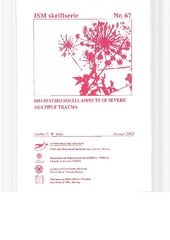| dc.description.abstract | Subjects with severe multiple trauma present great challenges in rehabilitation, and
investigations with a holistic bio-psycho-social point of view have been scarce. In the main
part of this investigation all 146 patients with severe multiple trauma (ISS 16) admitted to a
regional hospital in 1990. were target. Ten years survival probability for those discharged
alive from the Department of Surgery (fl: 91) was 82%. Mortality rates were significantly
higher than those of the general population, particularly during the first year after discharge,
during which the main cause of death was traumatic brain injury. Later, overuse of alcohol
and drugs, were the main causes of death. <br>
A principal aim was to analyse the relations between impairments/ functions. disabilities/
abilities and psychological and social well-being. In a three year follow-up investigation of 69
subjects (84% of those available), 80% had one or more residual impairments: 74% had
physical and 32°/g cognitive impairment. Very few subjects (n=4) were ADL-dependent.
Vocational disability was present in 19% and leisure disability in 76%. Vocational disability
was associated with higher age, blue collar work and cognitive impairment. Leisure disability
was most prevalent in those with severe physical impairments and residual pain. Cognitive
performance was significantly related both to the severity of traumatic brain injury and to
degree of psychological distress. <br>
A consecutive series of subjects with severe multiple trauma without brain injury (n:26),
were investigated at admission to the rehabilitation hospital, at discharge and at follow-up 1-
3.5 year following trauma. Both retrospectively and prospectively, the subjects experienced
significant decreases in satisfaction with life as a whole from before to after trauma. <br>
Furthermore, compared to before trauma, significantly fewer subjects reported to be satisfied
(5-6) with life as a whole, and with the domains: Sexual life. ADL, contact with friends, leisure, vocational situation and financial situation. Among the life satisfaction domains, the most important contributors for global life satisfaction after trauma. were satisfaction with leisure, family life and vocation. In multiple regression analyses, having a sufficient social network, and also a strong sense of coherence, could buffer the negative influence of disabilities on life satisfaction following trauma. <br>
Though level of sense of coherence was closely related to simultaneously measured social
well-being, the SOC was not stable over time, and the hypothesis about a strong sense of
coherence as protective against future distress and reduced satisfaction after stressful life
events could not be confirmed, at least not the first years after multiple trauma. | en_US |


 English
English norsk
norsk